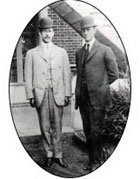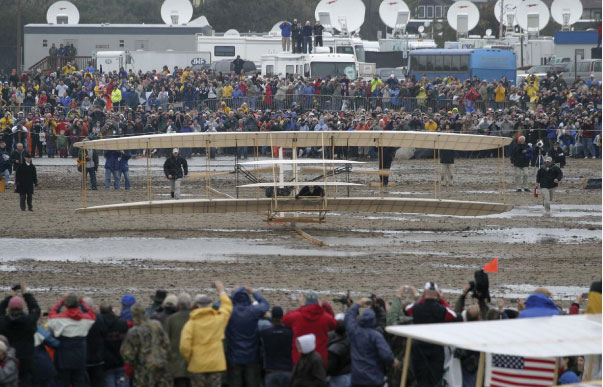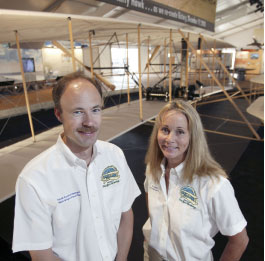Wilbur had already tried flying the new glider on Dec. 14 and crashed. Three days later, repairs to the flyer were complete and it was Orville's turn. With an audience of only five others--three men from the Kitty Hawk Life Saving Station and two locals who wanted to see what the commotion was about--Orville lay chest-down on the lower wing surface and fired the glider's four-cylinder, 12-horsepower engine. The twin propellers began rotating in opposite directions, and much to the Wright brothers' delight, the craft took off. The 120-foot, 12-second jaunt marked the first time humankind had successfully embarked on a powered flight. Orville's trip was the first of four flawless flights that day, the longest of which was Wilbur's 852-foot, 59-second flight, but the Wrights kept the news mostly to themselves, and details of the first flight didn't become widely known for several years. In fact, their penchant for secrecy about their work meant that there was no final blueprint for the craft the brothers dubbed "The Flyer." Almost 100 years later, this would pose a problem for modern aviators looking to replicate the Wrights' historic aircraft." The countdown begins
As the centennial of the Wrights' remarkable feat approached, an organization of aviation enthusiasts called EAA began making plans for "Countdown to Kitty Hawk," a yearlong series of events that would culminate in a re-enactment of the first flight. EAA contracted former American Airlines captain and Wright brothers expert Ken Hyde, who owns the Virginia-based Wright Experience, to build a working reproduction of the 1903 flyer. Hyde had previously been commissioned by the Army Aviation Museum at Fort Rucker, Ala., to reproduce the 1911 Wright Model B, an experience that showed him just how little of the brothers' work had been committed to paper. After Hyde signed on to build the 1903 flyer, he and the Wright Experience team--with the support of the Wright Family Foundation--spent five painstaking years researching the project, working backward from the original 1903 aircraft, which today hangs in the Smithsonian Museum’s new air and space annex. They also built full-scale reproductions of the Wrights' 1901 and 1902 models, for which there is more data, hoping to learn more about the 1903 version. When it was time to test the earlier reproductions, Hyde turned to Kevin Kochersberger (mechanical engineering '83; M.S. '84; Ph.D. '94). The two men had first met when Kochersberger, a Rochester Institute of Technology mechanical engineering professor, was helping his students test a replica 1896 Chanute hang glider. During the 2001-02 school year, Kochersberger took a sabbatical at Old Dominion University to test the 1901 and 1902 gliders in the Langley Full Scale Tunnel in Hampton, Va. The team then used the test data to build a $1.2 million Wright 1903 Flyer reproduction so exact that even the thread-count of the muslin covering the wings matched that of the original craft. The glider, however, was useless without a pilot. The Wright Experience team had decided that four people should be trained to fly the craft, with the two best pilots playing the roles of Orville and Wilbur on Dec. 17, 2003. Hyde, the first candidate, invited Kochersberger--who started flying hang gliders at 15 and now flies his own Piper Arrow--and two American Airlines pilots, Chris Johnson and Terry Queijo (animal science '78), to fill out the ranks. Queijo had already participated in an aviation first when she was named copilot of American Airlines' first all-female flight crew. Still, when Hyde invited her to join the Wright Experience team, she says that she asked herself, "'Of all the aviators in the world, why me?'" To train the pilot candidates, the team recruited legendary test pilot Scott Crossfield; in his own piece of Wright history, Crossfield, on the 50th anniversary of the first flight, had become the first person to fly at Mach 2. Now, he put the pilots in a 1902 Wright Glider flight simulator and an unpowered glider modified to perform like the 1903 flyer to teach them to fly using the Wrights' groundbreaking method of glider control. "The Wrights established themselves as leaders in aviation with the wing warping concept," explains Kochersberger. "In 1899, they constructed a kite with a five-foot wingspan and demonstrated that lateral control could be attained by 'warping' the wings of the biplane structure." This concept, which essentially turned the airplane by increasing lift on one wing and decreasing it on the other, was used in all Wright aircraft through 1912. To fly the plane, the pilot lies across the bottom wing in a movable hip cradle that he or she shifts to the left or right to control the direction of the plane--a process that Queijo describes as "challenging and physically demanding." She says that because the flyer is held together "with wires and rope, while the upper and lower wings are held apart by wooden sticks, the whole airplane flexes if you grasp a wing and pull forward," a far cry from her usual 225-ton Boeing 767. The flyer is also highly sensitive to wind, she notes. "Beyond even a small gust, it becomes very difficult to control. It feels a change in wind well before the pilot does, so it is capable of giving its passenger quite a hair-raising ride. The Wright brothers used to call it a 'bucking bronco.'" The group's extensive testing of the flyer revealed that it operated the most reliably when winds were between 12 and 24 mph and that the pilots had the most control, once aloft, at wind speeds of 22 mph to 28 mph. Armed with as much data as time had allowed them to collect, the team was ready for the re-enactment. In the meantime, Crossfield had made his decision: the two pilots would be Kochersberger and Queijo. Return to Kitty Hawk
In the days leading up to the planned re-enactment, Hyde and his team worried about the weather--the Dec. 17 forecast called for morning showers and afternoon thunderstorms. Additionally, there were some concerns about Kitty Hawk's landscape, which had changed a great deal since the turn of the century, and whether its numerous buildings would create turbulence and limit the range of wind directions. In spite of the weather conditions, the First Flight Centennial Celebration drew considerably more witnesses than the original event. The 35,000-plus people in attendance included some of aviation's greats, such as U.S. Sen. John Glenn, Chuck Yeager, and Neil Armstrong. During the six-day event, 100 aviation heroes throughout history were recognized, including the former astronauts and other pioneers such as Samuel Langley, Charles Lindbergh, and William Boeing. President George W. Bush--employing the very transportation technology made possible by the Wrights--was flown in on Air Force One and then helicoptered to the site to deliver a brief speech before the re-enactment. The amount of attention paid to the celebration didn’t go unnoticed by the two pilots. "The enthusiasm from the crowd was astounding," Queijo says. "Everyone waited in the worst weather possible, and I was humbled by their love of aviation history and their strong desire to get a glimpse of what happened 100 years ago." Kochersberger says that he hadn’t anticipated the "excitement and support for the heritage of aviation. I think I personally signed 3,000 autographs! There were people screaming my name and reaching their hands out. I'm just a mechanical engineering professor," he marvels, "but I believe that day, I was a conduit for the enthusiasm for the Wright brothers and what they achieved." Although the plan was for Kochersberger to pilot the glider at 10:35 a.m., the same time Orville had taken flight, the winds were too low. Then at 12:25 p.m., with winds approaching 10 mph, the team made the decision to give it a go. Kochersberger, wearing period costume, strode out to the flyer and lay down across the bottom wing. When he ignited the twin propellers, the crowd roared with excitement. "I didn’t feel pressure," he recalls. "I was able to take the two flights I had made and learn from them and apply that to the one on the 17th. I had in my mind what it was going to look like--I’d thought about it for weeks. Now, I look at pictures of me in the glider and think, 'Wasn’t I scared?' But I just blocked everything else out." Just as Kochersberger began moving down the flyer's take-off ramp, the winds abruptly dropped to 5 mph. The plane veered off the ramp and into the ground without ever becoming aloft. Much to the team's disappointment, the weather during the remainder of the day thwarted any further attempts. That the first flight couldn’t be re-created stands as a testimony to the ingenuity and effort of the Wright brothers, who made aviation history without today’s technology. "It took our large team of people in 2003 to try to do what the Wrights Now that the years of preparation for the event are over--and the re-created 1903 glider is in its permanent roost at the Ford Museum in Dearborn, Mich.--both pilots say they cherish the experience. "I learned a lot about perseverance, strength of character, and human spirit," Quiejo says. "Would I do it all again even if I knew the outcome? In a heartbeat." The experience also gave Queijo new appreciation for modern aviation. "Boy, am I glad the control system has changed over the past 100 years! Still, when I returned to the airplane at work, I felt reverence for all that has happened to create the airplane of today. I think it would have astounded the Wright Brothers to see the flying machine of today, knowing that it was borne of their invention." Kochersberger was equally glad to return to his day time job. "I’ve gone from this intense, heavily scrutinized project to just dealing with students asking why they got a particular grade on a test. It’s kind of reassuring." Ever the professor, he adds, "This experience will allow me to share the most exciting part of the Wrights' quest for manned, powered flight. As an educator, I feel it's important to show the next generation of Americans the payoff from innovative thinking and persistence that is central to the Wright story.” Given humankind's innate curiosity and ingenuity, one can only speculate about the kinds of groundbreaking achievements that other teachers will be sharing with their students 100 years from now.
|
|||||||||||||||||||||



 achieved in 1903--that says a lot about the quality of men that they were," Queijo says.
achieved in 1903--that says a lot about the quality of men that they were," Queijo says. 